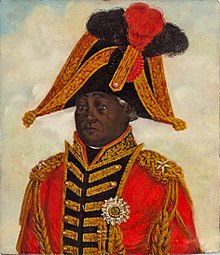
Back مملكة هايتي Arabic Rouantelezh Haiti Breton Regne d'Haití Catalan Haitské království Czech Nord-Haiti German Haitia reĝlando Esperanto Reino de Haití Spanish Royaume d'Haïti French Wayòm Ayiti HT Հայիթիի թագավորություն Armenian
This article needs additional citations for verification. (February 2024) |
Kingdom of Haiti | |||||||||
|---|---|---|---|---|---|---|---|---|---|
| 1811–1820 | |||||||||
| Motto: Ex cineribus nascitur (Latin) "Reborn from the ashes" | |||||||||
 The Kingdom of Haiti in the northwest of Hispaniola | |||||||||
| Capital | Cap-Henri | ||||||||
| Common languages | French, Haitian Creole | ||||||||
| Religion | Roman Catholicism | ||||||||
| Government | Unitary absolute monarchy (1811–1812) Unitary semi-constitutional monarchy (1812–1820) | ||||||||
| King | |||||||||
• 1811–1820 | Henry I | ||||||||
• 1820 | Henry II (not proclaimed) | ||||||||
| Legislature | Parliament | ||||||||
• Upper Chamber | Senate | ||||||||
• Lower Chamber | Chamber of Deputies | ||||||||
| Historical era | 19th century | ||||||||
• Proclamation of Henri Christophe as King Henry I | 28 March 1811 | ||||||||
• Death of King Henry I | 8 October 1820 | ||||||||
| Currency | Haitian livre, Haitian gourde (as of 1813) | ||||||||
| |||||||||

The Kingdom of Haiti,[1] or Kingdom of Hayti[2] (French: Royaume d'Haïti;[3][4] Haitian Creole: Wayòm an Ayiti), was the state established by Henri Christophe on 28 March 1811 when he proclaimed himself King Henri I after having previously ruled as president of the State of Haiti, in the northern part of the country. This was Haiti's second attempt at monarchical rule, as Jean-Jacques Dessalines had previously ruled over the First Empire of Haiti as Emperor Jacques I from 1804 until his assassination in 1806.

During his reign, Henri built six castles, eight palaces (including the Sans-Souci Palace), the Royal Chapel of Milot, and the Citadelle Laferrière, built to protect the Kingdom from possible French invasions. He created a noble class and appointed four princes, eight dukes, 22 counts, 37 barons, and 14 chevaliers.
After suffering a stroke and with support for his rule waning, Henri I committed suicide on 8 October 1820. He was buried at the Citadelle Henry. His 16-year-old son and heir, Jacques-Victor Henri, Prince Royal of Haiti, was murdered 10 days later at the Sans-Souci Palace by rebels.
Following the assassination of Emperor Jacques I, the country was split. Parallel with the government of Christophe in the north, Alexandre Pétion, a free person of color, ruled over the south of the country as President of the Republic of Haiti until his death in 1818. He was succeeded by Jean-Pierre Boyer, who reunited the two parts of the nation after the deaths of Henri I and his son in 1820.
- ^ d'), Laure Junot Abrantès (duchesse (1836). Memoirs of Napoleon, His Court and Family ... R. Bentley.
- ^ Daut, Marlene (23 January 2019). "Inside the Kingdom of Haiti, 'the Wakanda of the Western Hemisphere'". The Conversation. Retrieved 20 February 2024.
- ^ Rouzeau, A. (1818). De la République d'Haïti: île de Saint-Domingue, considérée sous ses différents rapports, ses forces, ses moyens physiques et moraux, et le caractère national de ses habitants : observations faites sur les lieux par M.A. Rouzeau (du Loiret) dans son voyage de 1817 à 1818 (in French). F. Didot.
- ^ Ardouin, Beaubrun (1860). Études sur l'histoire d'Haïti suivies de la vie du général J.M. Borgella (in French). Dézobry, Magdeleine et Cie.


